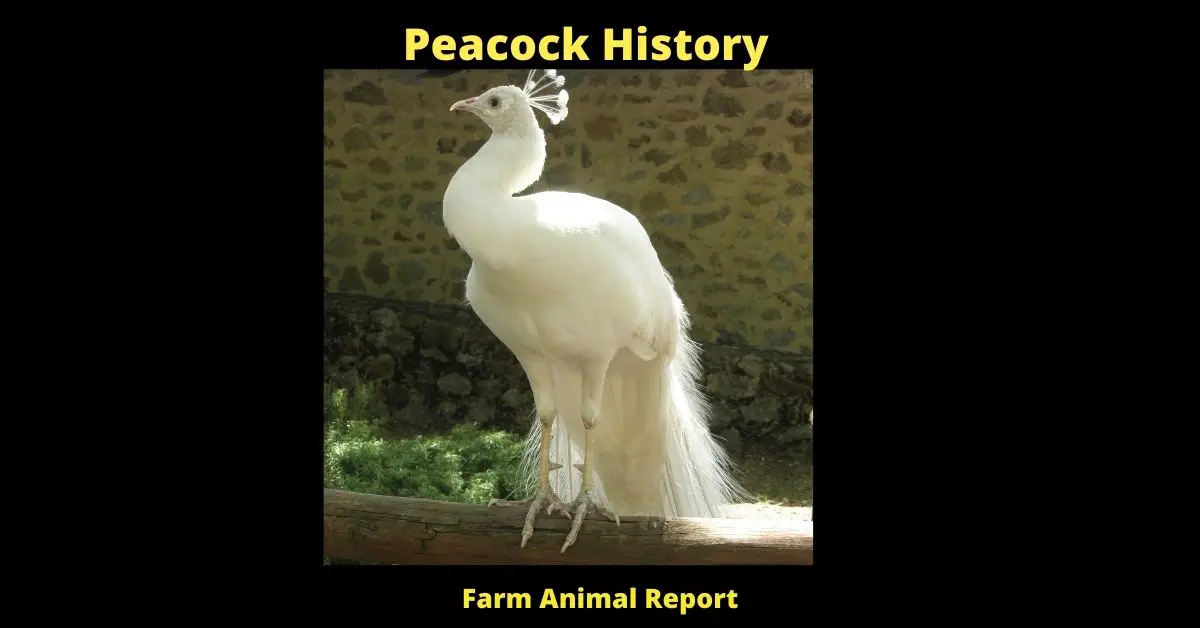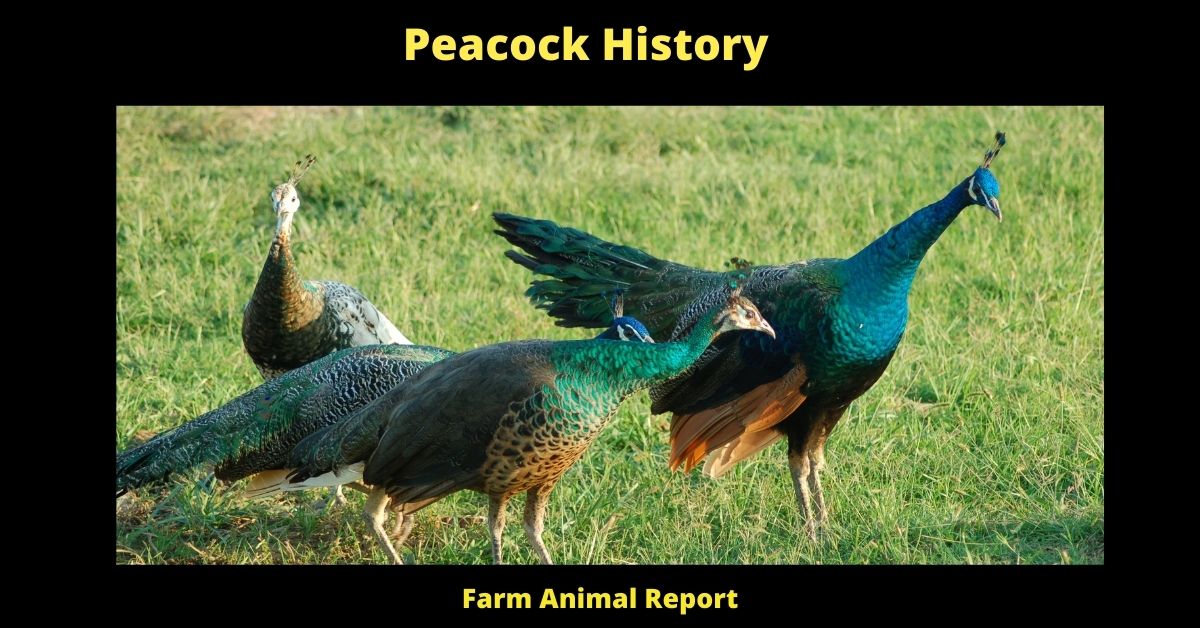As a general rule, male peacocks are much more colorful and beautiful than females. Female peafowls do not possess such beautiful feathers as their male counterparts who often have an elaborate crest on top of their heads with bright blue and green plumage. They originated in India and spanned across Asia and Africa.
Today, peacocks are considered a symbol of beauty and grace with their elegant feathers that make them stand out against other birds. They have been used in religious ceremonies as well as for food by humans throughout history and became endangered due to overhunting.
Peacock History
Peacocks are often associated with beauty and elegance. However, many people don’t know the history of peacocks or how they became so popular. The word “peacock” is derived from the Latin term Pavo cristatus which means “crested bird.” This name comes from their showy feathers that resemble a crown on top of their head. These beautiful birds were originally found in India but eventually made their way to other parts of the world like Europe and North America. Peacock feathers were also used for ceremonial purposes by various cultures around the world including Hindu royalty in India, Buddhist monks in China, Muslim royalty in Persia (modern-day Iran), and Christian priests throughout Europe during Medieval times.
Jump to Peacock Babys Peafowl – Extensive Guide

The peacock has been a symbol of royalty for centuries
Peacock History – Peacocks have a rich history, particularly those from India.
Peacocks have featured in some of the most famous works of art by artists such as Michelangelo and Rembrandt, among others. The peacock has even been a symbol for royalty – emperors used to wear clothes made out of peacock feathers with gold threads woven into them! They were also given away as gifts to important people.
In addition, the peacock is known for its beautiful feathers – they were even used as a religious offering in Indian culture! Today, though, they are more associated with fashion and embellishments on clothes. It’s believed that around three million birds are slaughtered each year just so their feathers can be used in fashion!
The peacock has made its mark on history, and it’s certain to continue doing so in the future.
Peacocks were first introduced to Europe by the Romans in the 1st century AD
Peacocks were first introduced to Europe by the Romans in the First Century AD. They brought them back from their expeditions into India and they quickly became popular because of their long tail feathers (and other parts). Peacock terms, like phrases involving peacocks, came about around this time in history.
The peacock was used as an emblem of royal authority during medieval times
The peacock was used as an emblem of royal authority during medieval times. They were seen around the necks of Kings and Queens on their crowns, shields or coats-of-arms until about 1800 A.D. It has been said that it may have symbolized Jesus Christ’s resurrection because after his death he returned to Earth in the form of a peacock. The male bird represented Christ and his resurrection because it is believed that he can turn stone to eggs, which are needed to create new life.
The green peacocks seen on coats-of-arms were not actually real birds but were stylized versions called heraldic fictions or visual puns (symbols based on puns). These were used to identify the owners of crests and coats of arms because they could not be identified by written signatures.
The peacock was also associated with pride, though traits such as beauty or vanity are often linked with it today. It was believed that when peacocks looked at their own reflection in the water, they became paralyzed by the sight of their beautiful feathers.
In Hinduism, the peacock is seen as a sign of good luck and prosperity
Hinduism is one of the world’s oldest religions. The peacock is a sacred bird in Hinduism. The word “peacock” itself comes from the Sanskrit term, Pavaka, and means “the spotted one.”
The first recorded use of an Indian peacock as a religious symbol was found on coins dating back to 450 BC. As time went by, it became more popular and eventually was used to decorate Buddhist temples.
The peacock’s history as a religious symbol is closely tied with the Hindu god, Kartikeya who represents victory and prosperity. In some stories of his birth, he emerges from inside an egg – much like a peahen does – thus earning him the title “peacock”.
Kartikeya is often depicted riding a peacock, or with one nearby. Because of this close relationship between the two, many Hindus consider it good luck to see a peacock and may even refuse to kill these birds out of respect for their god.
The sight of an Indian Peacock is still considered lucky in some parts of India. In Kerala, if a peacock turns up in the back garden it is thought to be an omen that an unmarried daughter will soon find her husband and in Gwalior, they are regarded as harbingers of rain

The bird has also been associated with royalty in Indian history since ancient times: paintings from Rajputana (an area of North India) dating back to the sixteenth-century show peacocks along with elephants, horses, and tigers.
The Peacock has also been used as a symbol in Western societies including Christianity since ancient times. One example is found in Ezekiel where Yahweh is described riding on a “fine-feathered Phoenix”.
The Greek god of the sun, Apollo is associated with peacocks as well. The Aaradahathi forest in South India features a temple dedicated to his mother, Hera that contains carvings of peacocks where it is believed she visited during her exile from Zeus. This story signifies how highly regarded these birds were for their beauty.
In the past, Peacocks were considered to be a symbol of royalty. In ancient Greece and Rome, they could only be killed by kings or emperors because it was believed that their feathers had magical powers of prophecy
The use of peafowl feathers in ceremonial robes became popular among Native Americans after European settlers arrived on their shores
Native American Indian tribes used peacock feathers in their ceremonial robes after European settlers arrived on their shores.
They used feathers in their headdresses and as part of their clothing.
The feathers were used in headdresses, with each feather carrying a specific meaning for the wearer based on its coloration.
They believed that peacock feathers would protect them from evil spirits.
Today, there are many different types of peafowl around the world, but all have one thing in common – they are stunningly beautiful creatures with elegant plumage that deserves to be admired

Types of Peacocks include
- the Indian Blue Peafowl, Pavo cristatus, from India and Sri Lanka. These birds have been domesticated for hundreds of years in both religious ceremonies as well as a source of food. The male has iridescent blue feathers on the head with a green body and chestnut tail. Females are smaller but otherwise resemble males with brown feathers and a white iridescent neck.
- The Congo Peafowl, Afropavo congensis, is found in the tropical forests of Central Africa. Males have black feathers with an iridescent blue hood that extends from their beak to the back of their heads. Females are much less spectacular with brown plumage and sometimes spotted eggs.
- The Green Peafowl, Pavo muticus, is a large bird that lives in the thick forests of South East Asia from India to China and Malaysia. They have been hunted for meat but are now considered endangered because the populations have decreased. Their coat has a metallic sheen with bright green feathers on their wings and tail while females do not have a crest and are generally brown.
- The Javan Peacock, Argusianus argus, is found in the forested regions of Indonesia where they feed on insects but also fruit. They have very long tails with elaborate eye-like patterns that make them unmistakable among other species. Females do not possess such beautiful feathers as the males and are more brownish with a white neck.
Jump To Pet Peacocks – ROYAL APPEARANCE
Final Thoughts
In Summary, Peacocks have a rich history dating back to ancient times. They were considered a symbol of royalty in both India and Greece, then later adopted by Christian societies as well.
Types of peacocks include the Indian Blue Peafowl, Congo Peacock, Green Peafowl, Javan Peacock, among others. All are stunningly beautiful birds with elegant plumage that deserves to be admired.

